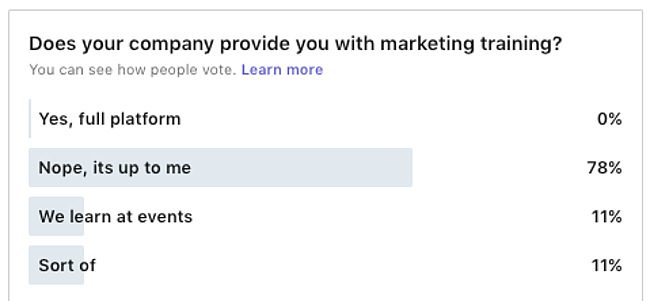NEW! Listen to article
We all know that marketing is both an art and a science.
It’s hard to measure the impact of brand on revenue, but we marketers know it has an effect. However, we work for businesses that have hard number targets and little interest in art.
That’s why you have to get the science of marketing right to have the freedom to do the art.
If you can nail both, you get…
- A seat at the executive table and the ability to guide company direction
- Freedom to do the things you know are great, meaningful, and right for your department and the company
- And (perhaps nearest and dearest to my heart) the end—or at least a minimization—of “Hey, look at what ‘Company X’ is doing. We should do that.”
Like Rodney Dangerfield, Marketing Gets ‘No Respect’
I can’t think of any other corporate occupation that changes more quickly than marketing. Just for geeky fun, I recently made a list of all the technology I’ve become proficient on in the last 20 years—with zero training:
Acrobat, PowerPoint, Word, Excel, InDesign, Illustrator, Photoshop, Dreamweaver, Salesforce, Marketo, Pardot, SharpSpring, HubSpot, HootSuite, Buffer, SurveyMonkey (now Momentive), Zoom, ZoomInfo, Constant Contact, Mailchimp, Act-On, Google Analytics, Omniture (now Adobe), Dropbox, Basecamp, Slack, WordPress, Sitecore, Drupal, Homegrown CMSs, Wix, Avid, Final Cut, LinkedIn Sales Navigator, Semrush. And I’m sure there are more that I’m forgetting.
Can you think of any other profession that needs all those tools in its wheelhouse? I can’t. And that’s just technology.
Let’s talk about strategy and tactics. We need to understand how to flawlessly execute branding, social, Web, search, paid ads, events, direct mail, PR, analyst relations, lead generation, webinars, videos, podcasts, blogs, messaging, sales tools, articles, and reporting—all with an eye to how those tactics generate revenue, influence buying decisions, and improve our brand position.
To top it off, most of us didn’t go to school for marketing; and even if we did, marketing changes so rapidly that a college degree in it becomes less and less helpful with each passing year.
Is it any wonder that marketers…
- Tend to have short tenures at organizations
- Often turn into little balls of stress and anxiety
- Feel alone and overwhelmed
No, Your CEO Doesn’t Know Marketing Better Than You—Here’s How to Push Back and Prove Marketing Effectiveness
I have never heard a CEO walk up to the accounting department and say, “Hey did you see the way Competitor Company is doing its spreadsheets? We should do that.”
Yet, it happens to us in marketing. All the time.
What you’re really hearing is frustration: CEOs can’t get a handle on what Marketing is doing and how it helps the company. They see what other companies are doing (because marketing efforts are super visible) and they wonder what their own investment is getting them.
Here’s how to prove Marketing’s effectiveness and avoid those awkward conversations.
1. Start backward
Know what the company goals are and align yours to them. Set a revenue (or at least pipeline) target for your marketing team.
If you can’t prove Marketing’s influence on revenue, you have to fix that. It should be your No. 1 priority. You will never get a bigger budget, more staff, or a promotion if you can’t prove real influence on revenue—and saying that a customer or prospect received an email doesn’t usually count in B2B.
This is the point where many marketers say, “But my sales team doesn’t follow up on the leads that I send them,” or “They don’t track data correctly in Salesforce.” I’ll say it again: fix it. This is your No. 1 priority!
Get friendly with the head of Sales, make deal source a required field in Salesforce, hire an SDR to follow up on Marketing leads by promising a real appointment target that they have to hit, attend regular team sales calls, run through new deals in Salesforce, and ask Sales where they came from. Whatever it takes.
2. Invest in your team
HR, Accounting, Sales—almost every other department in your company gets regular training. Yet in a recent (nonscientific) poll I did on my LinkedIn page, 0% of respondents said they got formal marketing training from their company, and a full 78% said it was up to them. The lucky ones (11%) said they received training at conferences a few times a year.
We can and must do better for our profession.

If this is the moment when you say “I don’t have budget for that,” remember that the average tenure of a CMO is the shortest of any C-level executive. I just listed all the tech and tactics marketers need to know right now, and I’m certain there’s more coming. Marketing teams must be in a constant state of learning and development to handle what’s now and to see what’s next.
Yes, marketing departments are way too small to handle the massive amount of heavy lifting they have to do. Yes, budgets are always getting cut. But too many new tools and tactics barrage us every day to not have everyone on the team cross-trained and exceptional.
3. Get really good at reporting
Every time we talk about engagement, clicks, and opens, our CEO, CFO, and CSO roll their eyes at us. Those are important leading indicators to us, but they’re not what we need to report on at an executive level.
By using a marketing automation system, having a good rapport with Sales, and establishing a few easy processes, marketing teams can and should be able to report on the following:
- Marketing-sourced deals that turned directly into pipeline (from events, downloads, webinars, contact forms, ads, etc.). I set it up like this: What is the primary activity that caused a contact to re-engage? For example, the prospect downloaded a paper, causing an SDR to follow up, which led to an appointment and then a deal. Deal source is “Web download” because that action started the chain. C-level financial people can accept that.
- Channels that drive the most pipeline
- ROI per channel (pipeline and closed deals)
- Lifetime value of the marketing activity (a customer who came to the company through marketing and continues to purchase)
- Lead flow—names to pipeline

The great thing about such reports is that you find interesting nuggets of gold for yourself and your team. You can start to see shifting trends and make truly informed decisions about where to spend your bigger budget.
Then, you will finally have freedom to do the art.
More Resources on Marketing Effectiveness
Proving Marketing to Execs (Part 1)
Three Ways to Strengthen the Marketing and Finance Relationship
These Four Data Points Demonstrate Marketing ROI to the C-Suite
Source link



